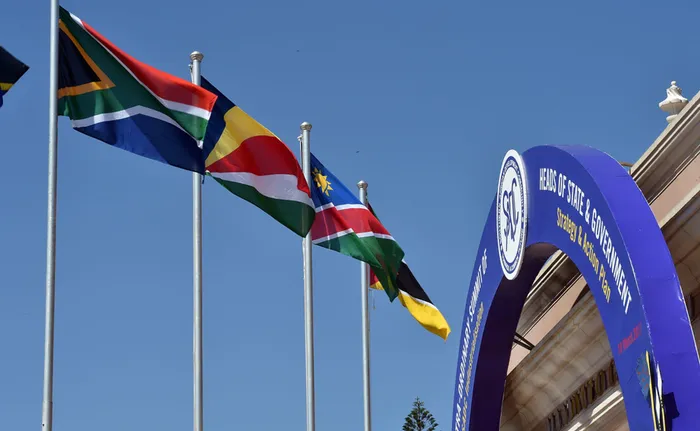The legislature has long been seen as the missing arm of the three arms of SADC

Picture: GCIS - Flags of the countries attending the Southern African Development Community (SADC) Extraordinary Summit of Heads of Government in Swaziland.
By Kizito Sikuka
The 42nd SADC Summit adopted a raft of measures to deepen regional integration and sustainable development in southern Africa.
The measures are contained in a communique released soon after the regional Heads of State and Government meeting held in Kinshasa, the Democratic Republic of Congo on August 17.
The theme of the summit was “Promoting industrialization through, agro-processing, mineral beneficiation, and regional value chains for inclusive and resilient economic growth.”
On peace and security, the leaders approved the extension of the SADC Mission in Mozambique (SAMIM) to help combat instability in northern Mozambique following increased acts of extremism, terrorism and insurgency.
The SAMIM was deployed in July 2021 and has assisted in restoring stability in the country, following the disturbances which had left thousands of people dead and displaced.
On the situation in eastern DRC, the leaders said they will engage the United Nations to explore all avenues to support efforts towards improving the security situation.
Eastern DRC slid into instability when a rebel group known as M23 resumed its terrorist attacks on citizens. The DRC has accused Rwanda of supporting the rebels.
With respect to the political situation in the Kingdom of Eswatini, SADC will soon convene an Extra-ordinary Summit of the Organ Troika plus Eswatini to find a peaceful and lasting solution to the security challenges facing the country.
The summit welcomed the establishment of the SADC Regional Counter-Terrorism Centre (SADC-RCTC) to be based in the United Republic of Tanzania, urging all Member States to strengthen cooperation and information sharing on terrorism, radicalism and violent extremism.
The RCTC is expected to advise SADC on counter-terrorism and prevention of violent extremism policies, programmes and deployments within the region; coordinate the implementation of the SADC Regional Counter-Terrorism Strategy, and lead the review process of the strategies.
Researching, assessing, analysing and timely dissemination of information to agencies tasked with national counter-terrorism and prevention of violent extremism agencies is also a key responsibility for the centre.
“Summit approved the appointment of H.E Jakaya Mrisho Kikwete, former President of the United Republic of Tanzania and H.E Paramasivum Vyapoory, former Vice President of the Republic of Mauritius as the Chairperson and Deputy Chairperson of the Panel of Elders, a SADC structure with the mandate to facilitate the prevention, management and resolution of significant inter and intra-State conflicts, and is supported by the Mediation Reference Group,” reads part of the communique.
On democracy, the leaders approved and signed the Agreement Amending the SADC Treaty on the Transformation of the SADC Parliamentary Forum into a SADC Parliament.
The approval of the much-awaited SADC Regional Parliament brings on board what has long been seen as the missing piece in the regional integration jigsaw puzzle.
A SADC Regional Parliament will ensure broader citizen participation in regional affairs. It will also facilitate more extensive debate on regional issues and thus accelerate the implementation of SADC protocols that need to be ratified and domesticated into national legislation.
This can become a key driver of integration and development, bridging the gap between citizens and policymakers.
The Summit decision is to establish the SADC Parliament as a “consultative and deliberative body” with no law-making or other binding authority in the initial instance.
The regional parliament is expected to observe and respect the sovereignty of SADC Member States while in operational terms it would consult and liaise with other SADC institutions and structures such as the Council of Ministers through which its recommendations would be channelled for consideration by Summit.
The Legislature has long been seen as the missing arm of the three arms of SADC, the other two being the Executive, represented by the SADC Secretariat headquartered in Gaborone, Botswana, and the Judiciary, represented by the Tribunal, based in Windhoek, Namibia.
The leaders also adopted and signed the Protocol against Trafficking in Persons to provide a framework of cooperation between Member States in combating trafficking in persons and associated transnational organised and cross-border crimes in the region.
Ms. Angele N’Tumba – from the DRC – was appointed the new SADC Deputy Executive Secretary for Regional Integration to replace Dr Thembinkosi Mhlongo from South Africa, who had served the Secretariat since 2014.
The 42nd SADC Summit also elected President Félix Tshisekedi of the DRC as the new SADC Chairperson, deputized by President João Lourenço of Angola, meaning the next SADC Summit in 2023 will be hosted by Angola.
President Hage Geingob of Namibia assumed the chair of the Organ on Politics, Defence and Security Cooperation, with his Zambian counterpart Hakainde Hichilema elected deputy.
The SADC Summit Troika and the Organ Troika are separate bodies, and the Chairperson of the Organ does not simultaneously hold the chair of Summit, but both positions rotate on an annual basis.
Sikuka is a Researcher and Writer with the Southern African Research and Documentation Centre (SARDC).
This article was first published in the SARDC